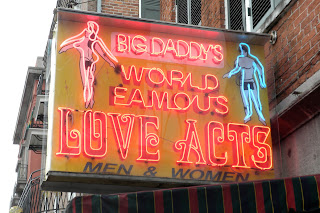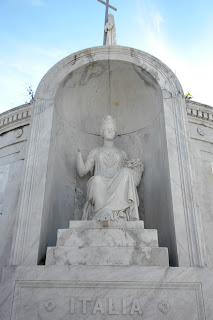For the first time on this trip, the weather turned against us so we spent the majority of our day inside, trying to escape the intermittent rain and miserable humidity. We started our day with a long hike to the far side of the French Quarter, site of Croissant d'Or, a bakery recommended in the guidebook as having authentic French pastries, and, not surprisingly given their name, excellent croissants.
My love affair with croissants dates back to my early childhood, when my parents took me to San Diego on vacation. According to them, I allegedly ate a croissant and a side order of bacon for breakfast every single day of our stay at the Hotel del Coronado. Mom often bought chocolate croissants for breakfast on special occasions, so the pastries have always been dear to my heart.
 |
| A deteriorating shotgun house in the French Quarter. |
In terms of food, I'm not sure that it was worth the walk to Croissant
d'Or. The pastries were good, but not as good as I've had elsewhere. The
atmosphere, however, was superb. The interior of the cafe boasted a
beautiful wall mural, but we chose to take our breakfast outside on
their covered patio, which featured a soothing fountain and a collection of exotic tropical plants. A local sitting nearby fed bites of a sausage-filled croissant to her whimpering pug/pit bull mix, and the tableau was enough to put both Justin and I into cuteness overload.
Duly fortified, we walked over to Jackson Square to go to the Presbytere, a branch of the Louisiana State Museum. The guidebook had recommended it based on the strength of its Mardi Gras exhibit, which it proclaimed one of the top attractions in the city. It did shed some light on the lesser-known aspects of the season, such as the balls staged by the krewes behind closed doors for an exclusive guest list, and the courirs of Acadia, the Cajun region of Louisiana. In this event, revelers in rustic costumes ride horses from door-to-door begging for food and pulling pranks. The gifts of food that they accumulate are later used to make a communal pot of gumbo from which the entire neighborhood will eat. In my opinion, however, the exhibit seemed pretty tired and dated. Most
of the artifacts looked like they came from the late 1980s to early
1990s.
Much stronger, I thought, was their exhibit entitled, "Living with Hurricanes: Katrina and Beyond." This exhibit combined artifacts with a powerful collection of oral histories to immerse the audience in the experience of New Orleans' residents during Hurricanes Katrina and Rita. It was deeply affecting, and very emotionally and politically charged. The exhibit then showcased a series of cleverly-designed interactives to help audience members understand the principles of levy and flood control engineering. Not being the most mechanically minded, it was helpful for me to learn by doing, and I think they would help illustrate such complicated topics for school children. Overall, I would highly recommend this section of the museum to anyone looking to understand the past, present, and future role of hurricanes and climate change on the Gulf Coast region.
 |
| Street musicians in Jackson Square. |
After lingering in the museum for a few hours, it was time to feed ourselves again, so we stopped by Johnny's Po-Boys, a French Quarter fixture with a daunting variety of po'boy options including the typical meat and seafood alongside more experimental options like french fries. That's right -- a french fry sandwich. This time around, Justin and I decided to go the fried seafood route -- me with fried shrimp and Justin with fried crawfish. I think his was a little tastier, but overall, we liked these sandwiches more than those at Mother's, though I think my preference is based largely on the presence of pickles on mine. Given that I sometimes eat a sometimes bowl of pickles as a meal when I'm not very hungry (don't worry, my blood pressure is so low I'm on the cusp of needing medication to raise it), the pickles on Johnny's po'boys won me over.
For our afternoon, we had planned to check out the Ogden Museum of Southern Art, in hopes of taking in some lighter entertainment than our morning spent dwelling on the legacy of Hurricane Katrina. We hopped on the St. Charles streetcar and headed over to the Central Business District, where many of the city's museums are located, only to discover that the Ogden would be closing in a mere hour in order to let their employees go home in advance of the Mardi Gras parade that was scheduled to pass their way that evening. Only going for an hour seemed like a waste of money, but we needed to stay in the area because we had a dinner reservation at 5:30 just down the street. As a compromise, we decided to check out the nearby National World War II Museum.
Initially, we had decided to skip this museum, not only because of its outrageous entry fee ($19 per person, $24 per person if you want to take in their "4-D Experience"), but because Dad had been and proclaimed it a bit of a let down after seeing the actual D-Day landing sites and accompanying museums during our 2007 trip to the Normandy coast. But, since it was convenient and open all the way until 5:00, we decided to give it a go.
I'm glad we decided to see the World War II Museum, as the exhibits were excellent, if a bit overwhelming. We definitely did not budget enough time to be there; we easily could have spent the entire day there. As it was, we got to thoroughly see the floor dedicated to the D-Day invasion, had about a half hour to spend on the Pacific theater, and only a couple minutes to breeze through the section on the home front and the role of New Orleans in manufacturing the landing craft employed on D-Day. Given that the last two sections were actually the most interesting to us, and we already knew the most about D-Day, we didn't plan our time there very well at all.
Still, I enjoyed seeing the various artifacts, and I was particularly impressed with their use of oral history to tell the tale of the war. Every so often, there would be a listening booth where visitors could sit down and listen to a series of two-minute oral histories from both veterans and civilian participants in the war effort. Considering my line of work, it's always nice to see oral histories in action, especially when integrated into a museum exhibit. Mostly though, I came away from the museum with a strong urge to go home and re-watch Saving Private Ryan.
 |
| Fried alligator in chili aioli at Cochon. |
We got kicked out the museum just before 5:00, so we walked a couple blocks over to Cochon to experience my most highly-anticipated meal of the trip. I first became aware of Cochon after reading a Thanksgiving feature in
Saveur that gave different regional menus for the holiday. One was a Cajun-inspired line-up, and they had interviewed Chef Donald Link for the article. His
turkey recipe caught my eye, and inspired me to do some research into his restaurants. After reading up on him, my inner foodie was convinced that I had to sample his food when I finally made it to New Orleans.
Initially, Justin and I were just planning on having lunch at Cochon Butcher, the sandwich/butcher shop that provides all the homemade charcuterie for Link's restaurants. It was really all we could afford, and the blogosphere proclaimed its sandwiches to be some of the best eats in the city. I was a little sad that we wouldn't be able to try out Cochon itself, but I would survive.
Then, before we left, Mom interceded and offered to pay for one meal while we were gone. I knew immediately what I would pick, and I was very fortunate to be able to get a 5:30 table. They book fairly far in advance, and all the more desirable times had been long-since claimed, especially with Valentine's Day and Mardi Gras falling so close to each other. I was very excited!
Thankfully, the food did not let us down. In fact, even if it wasn't the fanciest or most expensive meal we ate during our trip, it was definitely my favorite.We started off the evening with two appetizers to share: the fried boudin balls and fried alligator in a chili aioli. Ever the devotee of encased meats, I'd been dying to try boudin -- a Cajun sausage consisting of pork, liver, and rice -- ever since we arrived in New Orleans, and I was glad I waited to try Donald Link's version at Cochon. Simply put, it was incredible. I don't know where I'd be able to find boudin in my neck of the woods, but when I get home, I'm going to make a valiant effort. Furthermore, the alligator was far and away the best I've ever had. There was no trace of toughness, which has been a problem with alligator I've had in the past, and the spicy sauce that accompanied it was a perfect foil.
 |
| Louisiana cochon at Cochon. |
The entrees, however, were where Cochon really shined. My rabbit and dumplings were completely spot-on; the rabbit was moist and tender, while the dumplings had a perfect consistency and a gentle herbaceous presence to them. The whole dish basically tasted like the most delicious chicken pot pie you'll ever eat. Justin went with the "Louisiana cochon" a dish consisting of impossibly juicy, roasted pulled pork, formed into a patty and seared for crispness on top of a bed of root vegetables and apples, with a garnish of a shatteringly crisp pork rind. The entire thing was pure, unadulterated porcine heaven.
Really, the only weak link in the meal was dessert, which, for us, consisted of a lackluster piece of carrot cake. My only regret about the meal was not ordering a charcuterie plate in lieu of dessert -- I'm sure it would have been much tastier. If you take away one piece of advice from my experiences in New Orleans, let it be this: go to Cochon! As for me, now that I've eaten his food, I'll be tracking down a copy of Donald Link's Real Cajun cookbook when I get home.
 |
| Justin and his friend, Stephen, in the lobby of our hotel at the end of our evening. |
Right after dinner, we met up with Justin's friend, Stephen, again. Stephen took us on a mini-bar crawl through New Orleans, stopping at some of his favorite spots and pointing out others. Drinking isn't exactly my favorite pastime, but Justin got to spend some time catching up with his friend and I got to spend some more time getting to know him better. We ended the evening at the hotel's Sazerac Bar, where Justin sampled its eponymous cocktail, which has a long and storied history in the city. Its combination of absinthe, bitters, and a whole lot of whiskey did not appeal to me in the least, but at least Justin seemed to enjoy it.
Slightly inebriated and tired from our long day of museum-going, Justin and I bid adieu to Stephen relatively early, before turning in for our last night at the Roosevelt. At least we didn't have far to go...






























